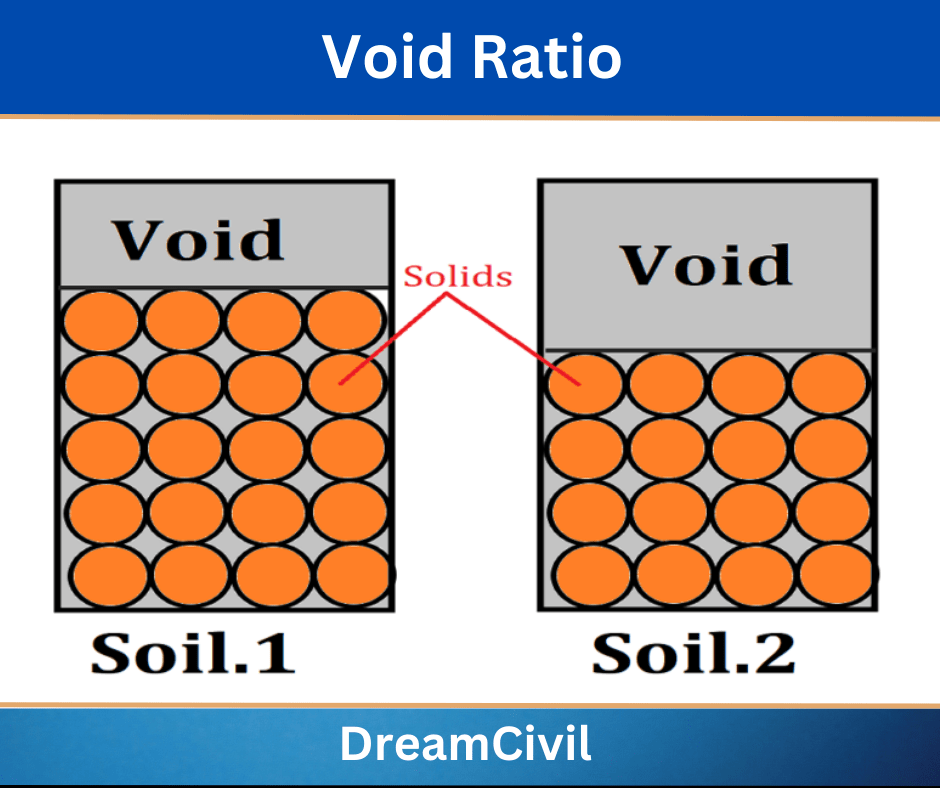Table of Contents
The void ratio may be defined as the ratio of the volume of voids to the volume of the solid.
It is generally denoted by e.
Mathematically,
e = Vv / Vs
where,
Vv = Volume of voids
Vs = Volume of the solid
a. Relation Between Void Ratio and Dry Unit Weight
1. The void ratio is calculated for each state of the denseness of the sample.
2. Maximum void ratio takes place at minimum index density.
3. Minimum void ratio takes place at maximum index density.
The relation between void ratio and dry unit weight is given as:
| e = ( G x γwater -γdry ) / γdry |
Where,
G = specific gravity
γwater = Unit Weight of Water
γdry = Dry Unit Weight
b. Relation Between Porosity and Void Ratio
The porosity of soil may be defined as the ratio of the volume of voids to the total volume.
Mathematically,
n = Vv/V
Where,
Vv = Volume of void
V= Total volume
The void ratio is normally utilized in parallel with soil porosity.
Porosity is denoted by n.
The relationship between void ratio and porosity is given as:
| e = n / (n-1) |
or,
| n = e / (e+1) |
c. Relation Between Air Content and Void Ratio
Air content may be defined as the ratio of the volume of air in the soil mass to the volume of voids in the soil mass.
Air content = (Va /Vv) = Va / (e * Vs)
Va = Volume of air
Vv = Volume of voids
d. Relation Between Degree of Saturation, Specific Gravity, Water Content, and Void Ratio
The degree of saturation may be defined as the ratio of the volume of water in the soil mass to the volume of voids in the soil mass.
It is denoted by ‘Sr‘.
The degree of saturation is normally expressed in a percentage.
The degree of saturation is equal to 0 when the soil is completely dry and 100% when the soil is completely saturated.
The relation between the degree of saturation, specific gravity, water content, and the void ratio is given as:
| W x G = e x Sr |
where,
W = water content
G = specific gravity
e= Void ratio
Sr = Degree of saturation
e. Relationship Between Permeability and Void Ratio
The coefficient of permeability is different from the void ratio as e²/sup >/(1+e).
For a given soil mass, if the void ratio is more then the value of the coefficient of permeability is higher.
Based on different concepts it has been found that the permeability of soil is different from e² or e²/(1+e).
Whatever may be the exact relationship, all soils have e Vs log k drawn as a straight line.
K increase with the increment of Void.
( K = Coefficient of Permeability )
f. Numerical
1. A soil sample having a weight of 0.7 kg and a volume of 3.5 × 10-4 m³. After drying out, the weight was decreased to 0.6 kg. The specific gravity of the particle is given at 2.6.
Determine the following:
a) Moisture content
(b) Dry density
(c) Bulk density
(d) Void ratio
(e) Porosity
(f) Degree of saturation
Solution,
| (a) Moisture content The total mass of water (Mw) is 0.7 – 0.6 = 0.1 kg m = Mw / Ms = 0.1/ 0.6 = 0.1666 or in percentage 16.66% | (b) Dry density ρ Dry = Ms / V = 0.6 / 0.00035 = 1714 Kg/m³ | (c) Bulk density ρ Bulk = M / V = 0.7/ 0.00035 = 2000 kg/m³ |
| To determine the void ratio we must first determine the volume of solids.
(a) ρ s = Ms / Vs = Gs ρ water ∴ Vs = Ms /( Gs ρ water) Vs = 0.6 / (2.6 x 1000) Vs =0.000231 m³
(b) Vv=V-Vs = 0.00035-0.000231 = 0.000119 m³
(c) Vw = 0.1 / 1000 = 0.0001 m³
(d) Void ratio (e)= Vv / Vs = 0.000119 / 0.000231 = 0.515
(e) Porosity (n)= Vv / V = 0.000119 / 0.00035 = 0.34
(f) Degree of Saturation (Sr) = Vw / Vv = 0.0001/0.000119 = 0.84 = 84 % | ||
g. References1. Content Filter & Authenticity Checking Team, Dream Civil International (Our team checks every content & detail to maintain quality. )
|
Read Also: Irrigation with All Methods

